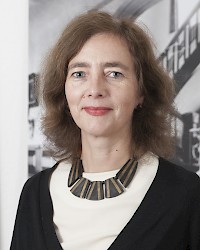Vita
Petra Löffler, born 1968, has been a Visiting Professor for Kulturtechniken and Wissensgeschichte at the Humboldt Universität zu Berlin since April 2015. Having studied literature studies, art and education in Erfurt as well as German language and literature studies, art history and slavic studies at the University of Cologne, she graduated in 1995 and received her Ph.D. in 2003. Her dissertation entitled “Affektbilder. Eine Mediengeschichte der Mimik” was published in 2004 and awarded with the Preis der Offermann Hergarten-Stiftung at the University of Cologne. From 2005 to 2011 she has been a Researcher at the Institut für Medien-, Informations- und Kulturwissenschaft at the University of Regensburg and the Institut für Theater-, Film- und Medienwissenschaft at the University of Vienna. In 2010 Löffler was Visiting Professor for Media History and Visual Culture at the University of Siegen before being appointed Professor for Media Philosophy at the Bauhaus-Universität Weimar in 2011. In 2012 she gained her venia legendi for film and media studies. Her habilitation entitled “Verteilte Aufmerksamkeit. Eine Mediengeschichte der Zerstreuung” was published in 2014. Since 2008 Petra Löffler is a member of the editorial department of the “Zeitschrift für Medienwissenschaft”.
Dated from 2016
Fields of research
Media archaeology; media and cultural theory of the affect; media of distraction; early cinema; digital archives; media ecologies.
IKKM Research Project
Phantom Matters
This project intends to sketch a spectrology that investigates phantomatic modes of production. According to Jacques Derrida such a phantomatic mode is “at work in any tekhne” (Specters of Marx, 97), revealing the uncanniness of any appearance, of any product. What makes this uncanniness work, for him, is an impersonal ‘operation without act’, that means an operation without a real subject or object. This impersonal operation I want to consider as a mode that makes-appear or makes-disappear: appearing, disappearing or reappearing is, so to speak, simply an operative mode delivering forces, movements, and affects. Thus, these tripartite operations of appearance, disappearance and reappearance do not only concern the interplay of presence and absence of any material or any matter, they also affect spatial and temporal relations. To speak of ‘phantom matters’ in this way means first to highlight the active role matter and materiality play in such a spectrology, and second to underline the productivity of the phantomatic mode itself.
- The project will develop this twofold perspective by looking at the mixed materiality of photographs and films – the only temporally stable combinations of chemical substances and materialities such as collodion and glass or nitrate and cellulose. Those combinations are not only highly sensitive to light, but also easily inflammable – this is to say, they are ‘phantom matters’ that perform sometimes a dangerous activity. There are for instance, huge amounts of nitrate films from the period of silent cinema up to the 1950ies that were burnt and have disappeared forever. The transformative nature of film as matter is also subject to experimental filmmakers or auteurs working directly with film footage (Ken Jacobs) or using damaged footage (Bill Morisson) or demonstrating film’s damageable materiality and its possible uncanny dematerialization (Ingmar Bergman’s Persona).
- Apart from the cycles of appearance, disappearance and reappearance of media-materiality the project will analyze the special role certain materials such as curtains, draperies or handkerchiefs play as cinematic objects for a spectrology. These materials were used not only by magicians and filmmakers alike to make something or someone appear or disappear, but also to blur spatial dimensions and to disconnect or conjugate temporalities. That’s why I will speak of them as ‘phantom matters’. Furthermore, cinematic techniques such as stop trick, multiple exposure or superimposition multiply the ways in which a spectral appearance or disappearance is produced.
- The project will also regard natural forces and meteorological phenomena such as wind, storm etc. as ‘phantom matters’. Here, I follow the assumption that also invisible environmental forces are able to make something or someone appear, disappear or reappear. Nowadays meteorological disturbances are widely discussed in the context of climate change and global warming. The imagination and simulation of climate disasters is not only subject of advanced scientific research, but a widely common topic of blockbuster film and popular culture as well. In this perspective the notion of ‘phantom matters’ can reveal the strange productivity of hyper-objects such as nuclear clouds or thunderstorms. Observable effects such as the contingent appearance and disappearance of moving matter, things, human and nonhuman beings are truly operations without a real subject or object in Derrida’s sense.
Publications
Monographs
Verteilte Aufmerksamkeit. Eine Mediengeschichte der Zerstreuung. Zürich/Berlin: diaphanes 2014.
Affektbilder. Eine Mediengeschichte der Mimik. Bielefeld: transcript 2004.
Edited Books
with Florian Sprenger: Zeitschrift für Medienwissenschaft 14, (Schwerpunkt: Medienökologien) Forthcoming 2016.
with Kathrin Peters: Zeitschrift für Medienwissenschaft 3, (Schwerpunkt: Aufzeichnen) 2010.
with Joanna Barck: Gesichter des Films. Bielefeld: transcript 2005.
with Leander Scholz: Das Gesicht ist eine starke Organisation. Köln: DuMont 2004
Articles
“Diffracting Kittler: On Coexistence, Distributed Objects and Collaborative Media Practices”. In: Mercedes Bunz, Marcus Burkhardt (eds.): Diffracting Kittler: German Media Theory Today forthcoming 2015.
“Geister der Stadt. Spektrologie urbaner Räume. In: Ralph Fischer und Gerald Siegmund (eds.): ‚Lernen, mit den Gespenstern zu leben’. Das Gespenstige als Figur, Metapher und Wahrnehmungsdispositiv. Berlin: Neofelis Verlag 2015, pp. 167-186.
“Im Raum sein: Streuen, Erstrecken, Zerstreuen. Zu einer Medienökologie des Relationsraums”. In: Zeitschrift für Medienphilosophie und Kulturtechnikforschung, 5/2 (2014), pp. 209-223.
“Der seltsame Fall des Bas Jan Ader. Los Angeles und der West-Coast-Konzeptualismus der siebziger Jahre”. In: Augen-Blick. Konstanzer Hefte zur Medienwissenschaft, 59, 2014, pp. 10-22.
“Bodies of Distraction”. In: Bianca Maria Pirani, Thomas S. Smith (eds): Body and Time. Bodily Rhythms and the Social Synchronism in the Information Age. Cambridge: Cambridge Scholars Publishing 2013, pp. 8-20
